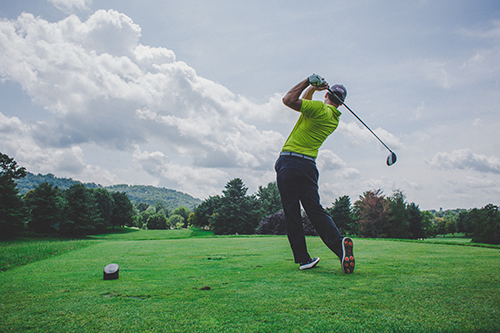Endeavouring for a jazzed-up golf swing could participate in havoc with your back, according to US doctors.
The modern “X-factor” swing favoured by many experts may well hit balls harder and further, but it can likewise adds extra pressure on the spine, says experts at the Barrow Neurological Institute.
They look at what happened to Tiger Woods in their research, which was published in the Journal of Neurosurgery.
The 43-year-old professional recently made a comeback after some serious back problems.
Swinging the golf club at a measured speeds of 129mph at the April 2018 Master’s Tournament, Tiger Woods seems to be back to an excellent condition.
Moreover, he has stated that he currently has a greater understanding of what he “can and can’t do” this season.
“A great deal of it has been training and attempting to get stronger,” he said.
Big Swing
An X-factor golf swing strives to get the ultimate spinning of the player’s shoulders relative to their hip bone at the very top of the backswing.
This big rotation generates overwrought energy – the X-factor – but Dr Corey Walker, Dr Juan Uribe and Dr Randall Porter, from Barrow, said it might well come at an expense, twisting the lumbar spine.

The spinal surgeons have been researching how the present-day golf swing of professional players, including Tiger Woods, differs from the ones of golf veterans, such as Jack Nicklaus and Ben Hogan.
They explain that athletes’ physiques and techniques have changed considerably over recent decades.
Modern-day players are more muscular and have more powerful downswings, and this can put enhanced pressure on the facet joints and the sinal disc, they believe.
Also, over time, it can result in a destructive process that the publishers call “repetitive traumatic discopathy” (RTD).
Wear and tear
However, it’s not just the backswing which might injure the lower spine.

During the course of an explosive downswing, lateral flexion can result in a ‘crunch” of the side of the spine, putting the strain on the disc and facet joints on one side of the spine, they mention.
Dr Walker said: “We think Tiger Woods’s experience with spinal disease highlights a real and under-recognised issue amongst modern era golfers.
“Tiger was applying the methods of the modern day swing, and that puts a tremendous level of stress on the back.”
” It’s still a theory nevertheless we are starting to see the late stages to this in many of our patients”.
” We are seeing elite level golfers, younger and younger with some sort of degeneration in their lower back.”
He said every golfer, professional or not, who sufffered any type of pain should seek expert help of a physiotherapist.
Woods had mutiple spine injury before returning to fitness. He also did a ton of physiotherapy and reinforcing exercises in the gym.

At PhysioDNA Oakville, we have a fully integrated approch to Physiotherapy not only as a mean to help you recover from falls, injuries or treatment, but more importantly as a way to prevent injuries and potential heavier treatments resulting from years bad habits and/or advices.
As part of our continuous effort to help our clients integrate a hollistic approach to Physiotherapy, we offer unique fully integrated solutions.
You can call us directly or book an appointment online with one of our Registered Physiotherapist in our Oakville Clinic.
Get in touch with us and tell us about your situation. CALL NOW or book online today for an assessment. There is always a way to get in touch with us, 24/7. We’re here to listen, whether you are looking to get better, increase your performance or recover from injuries and pain, we look forward to hearing from you.

